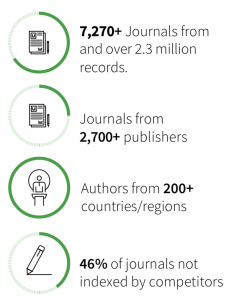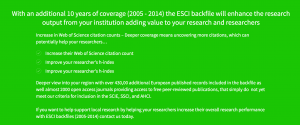The Emerging Sources Citation Index (ESCI) deepens and broadens your current Web of Science coverage— delivering the most comprehensive discovery across areas of research in journals of regional importance, not found in more established journals. 10-year backfile now available!
Supporting regional discovery needs, ESCI connects to the more than
1.4 billion searchable citations
across the Web of Science
ESCI is the ultimate resource for:
- Searching and discovering new areas of research and emerging sources
- Identify new collaboration opportunities in emerging research areas
- Expandedresearchassessmentandbenchmarking
- Discovery of new scholarly content around the globe
- Greater perspective to your institutional research output
- Discovering thousands of new publishers and journals from independent, scholarly societies
- Real-time insight into a journal’s citation performance while the content is considered for inclusion in other Web of Science collections.ESCI fills the need within rapidly changing research fields and the rise of interdisciplinary scholarship
The ESCI connects to all of the more that 1.4 billion searchable citation across the Web of Science—ensuring the most complete global view of the best available research. All records in the ESCI are searchable, discoverable, and citable so you can measure the contribution of an article in specific disciplines, as well as discover connections to new research in new disciplines.
Now available! ESCI backfile—10 years (2005-2014)
The ESCI backfile provides access to over one million new records—deepening discovery and exposure
to past research across the ESCI portfolio.

ESCI backfile covers:
- 5,600+Journals
- Over 1.4 million new records
- Over 50 specialty areas
- 54% of records are new Social Sciences and Arts & Humanities content!
- 81% of content from outside of North America
- 53% of content from outside North America and Western Europe
- 35% OPEN ACCESS—1,980+ open access journals, providing easy access to free full text
- Available for the first time anywhere— one-time purchase!
Editorial process
All journals in the ESCI have been rigorously hand- selected and reviewed by our editorial team as important titles to key opinion leaders, funders, and research evaluators worldwide. They have passed an initial editorial evaluation and can continue to be considered for inclusion in the Science Citation Index Expanded, Science Citation Index Expanded, Social Science Citation Index, and Arts & Humanities Citation Index, which have their own rigorous evaluation processes and selection criteria. All ESCI journals are indexed according to the same data standards, including cover-to-cover indexing, cited reference indexing, subject category assignment, and indexing all authors and addresses.
The Web of Science is the most accurate and comprehensive resource for research discovery and evaluation, and our independent and unbiased journal selection ensures the highest quality indexing. The ESCI makes our rigorous selection criteria more transparent by exposing new content earlier in the selection process—helping everyone to make more connections to new areas of research, and discover more journals of regional importance.
For more information:
info.clarivate.com/ESCI
ESCI has a positive effect on research assessment and it accelerates communication in the scientific community
Early Insight on the ESCI: an overlay map-based bibliometric study. Scientometrics, 18 March 2017

Leave a Reply